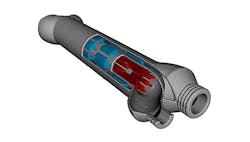More Efficient Heat Exchangers Emerge
Significant improvements in heat exchangers now are possible because recent advancements in 3D printing allow designs previously thought impossible, note researchers at the University of Illinois at Urbana-Champaign, Urbana, Ill. They have coupled metal 3D printing with software tools using topology optimization to create more-efficient, compact tube-in-tube heat exchangers.
“We developed shape optimization software to design a high-performance heat exchanger,” explains William King, professor of mechanical science and engineering at the university’s Grainger College of Engineering. “The software allows us to identify 3D designs that are significantly different and better than conventional designs.”
Pairing the shape optimization software with additive manufacturing, the researchers designed fins internal to the tubes in a tube-in-tube heat exchanger. The team then 3D printed the tubes using a powder-based metal additive manufacturing process.
“Any material that can be made with powder-based metal additive could be used. There are dozens of these materials available today and the list continues to grow,” says King.
“The additively manufactured tubes can handle the same service range as conventionally manufactured tubes. The pressure and temperature range could go much higher because of the materials available in metal additive manufacturing,” he points out.
“Our optimized heat exchanger has about 20 times higher volumetric power density than a current state-of-the-art commercial tube-in-tube device,” adds Nenad Miljkovic, associate professor of mechanical science and engineering and co-study leader.
Details appear in an article in the journal Joule.
The optimized device also performs well compared with shell-and-tube and brazed plate heat exchangers designed for significantly higher heat transfer. “There is a great potential to innovate on the sizes and shapes of heat exchangers, using additive manufacturing to create new three-dimensional shapes that can lead to high performance. Over time, we will see these types of innovations impact all types of heat exchangers and applications,” believes King.
The compactness of the tube-in-tube exchanger offers a variety of savings, e.g., in fluid inventory and support structure requirements, among other advantages. “In designing this heat exchanger, we were considering mobility applications — electric cars and electric airplanes — as real opportunities for compact heat exchangers. There are other benefits, for example small heat exchangers use less fluid and less pumping power. They also are smaller to store and transport, and use less material leading to additional sustainability benefits,” elaborates King.
The tubes created by 3D printing also are extremely robust, note the researchers. “The materials are quite strong. Modern additive manufacturing can produce metal parts with high strength, close to zero porosity, and low surface roughness,” King stresses.
However, like with any heat exchanger, small passages can lead to fouling, he cautions. “The fouling issues would need to be managed the same way that one would do for a conventional heat exchanger with the same sized passages.”
The approach extends to other types of heat exchangers as well: “Using generative design to find high-performance, three-dimensional shapes, and additive manufacturing to realize these shapes could be applied to any type of heat exchanger including shell-and-tube heat exchangers and plate-and-fin heat exchangers,” says King.
“Just about every company making heat exchangers is closely monitoring the development of additively manufactured heat exchangers, because there are significant performance benefits that can be unlocked. There are only a few commercial applications of additively manufactured heat exchangers, but these will increase over time,” he concludes.
